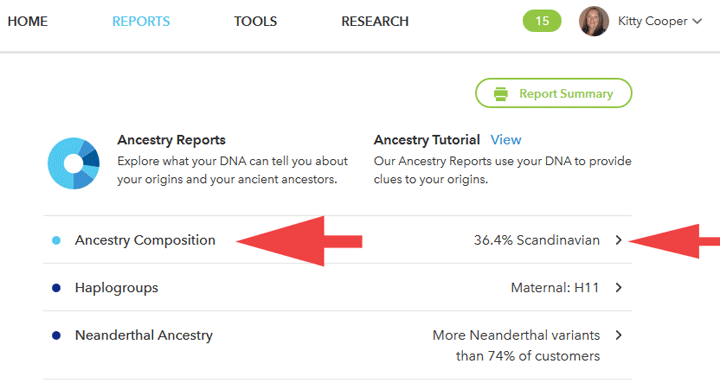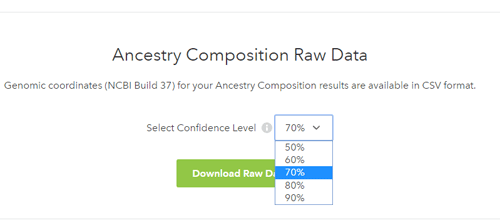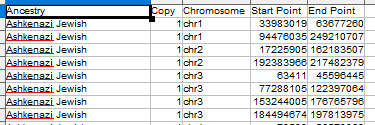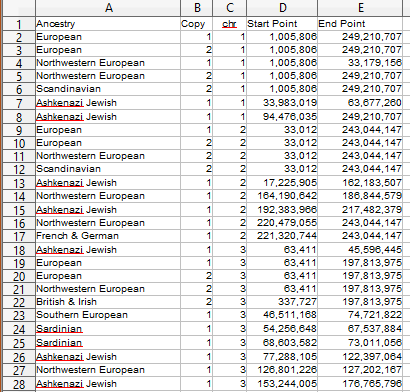Did you know 23andme now provides the segment data for its ancestry composition assignments? This is a pretty recent feature and might even be useful. Unlike the other companies, 23andme does its admixture (aka ancestry composition) in chunks. This may make it more accurate than the others but in any case it means that they can give us the segment numbers. Then we can compare those to our matches.
To get these numbers, first pull down the reports menu and click on ancestry. On the initial ancestry page click on Ancestry Composition or the > symbol next to your highest group. Both are marked with my red arrow below.
The next page, the ancestry composition page has the pretty chromosome picture with ancestries displayed where you can change the confidence level from speculative (50%) to conservative (90%). To get a CSV file of the segments you click on Scientific Details at the top or the bottom of this page.
Then scroll all the way to bottom of that next page until you see this. You can select your confidence level as well for your downloaded data.
The resulting CSV file looks like this. Notice the column “copy.” My results are phased with my Dad so his contribution is copy 2 and mom copy 1. Without that phasing they can only guess which copy a result belongs on.
It’s not very compatible with other segment files in this format. So I remove the word “chr” to leave just the number and then center it. I always add commas to the start and stop numbers so I can read them more easily. Then I sort by chromosome and start points.
To the left is an excerpt from my reformatted version, by the way it is the speculative version. I doubt the Sardinian but it might be part of my ashkenazi grandad’s contribution…
Notice that all the ancestral areas and subareas are listed for the same segments, So European, Northwestern European and then the interesting breakdowns.
I will report back in the future if this is at all useful. Do remember that ancestry composition results are not very accurate yet for any company so always take them with a large grain of salt.





OMG!!! <3 <3 <3!! So excited for this!
Wow that’s cool! Great thanks for the information Kitty!!
Thanks so much for this! It was on Monday when I was just looking at 23andme and was hoping to find start/end points on these, looked at the source page (or whatever it’s called) of the actual website to see if I could see numbers, and here you mentioned this, and this was exactly what I needed! Now I have the actual segment of one particular “european” segment that did not come via my mother, but via my father and of whom my paternal aunt and one of my paternal 1st cousins also share in the exact same place.
I feel like those “ethnic/ancestry” hunters who deal strictly with the ancestry portions of these tests, and end up blogging about it. hahaha Thanks again Kitty!!!!
I find this Very interesting. If I understand it correctly, it can be used to evaluate how other “matches” are related to my father or my mother.
Also, I’m a little lost in terms of the segment size. Is it appropriate to use it as a way to see where others overlap in the same Chr, or is the length of the measurement important?
John – I expect to use this in conjunction with the overlapping segment data available from the DNA view in DNA relatives or the traingulation view, see other posts on 23andme or http://blog.kittycooper.com/2016/08/more-about-dna-relatives-at-the-new-23andme/
I do not see the screens to which you are referring. I am wondering if I have the older version and not the new updated version of 23 and Me. They mention that they are transitioning over to the new version, but I just got my results in late November, so I don’t know which version I have.
Terry, if you just got your results then you should be on the new version. Look through my other posts for some more help for 23andme http://blog.kittycooper.com/tag/23andme-new-site/
They seem to have gone out of their way to make the navigation difficult!
@mskitty, @terry: actually not true, if you are international, you still get the old experience, even now.
Kuba, thank you so much for that clarification!
Unless they have improved the ethnicity estimates, I don’t expect great results. I did this manually for over 3 years comparing my segments assignments to cousins and their segments ethnic assignments. Their ethnicity guesstimate very rarely agreed with mine. For example, I would be assigned British/Irish on a segment and they’d be assigned German. Of course, there is lots of room for tomfoolery when you don’t have a parent to run against your results as it ends up looking like: French/German//Northern European for me and English/Irish/Southern European for them. There were many instances where both of us might have a ‘Northern European’ assignment but that’s so general and uncertain if it’s the matching chromosome we share or not – or the other chromosome… who knowsA!
The ethnicities in my family that are totally accurate are Ashkenazi and Finnish. Those populations seem very distinct. Other Europeans are more amorphous, plus judging from our matches, our Norse ancestors had relatives who settled or did other things in Ireland and Scotland and England …
I had more luck with this, having a 2nd cousin match who was not as mixed as myself. There were only 2 places where I have both chromosomes with similar breakdowns that I couldn’t be sure of. I really really really hope my Dad sends in the kit I gave him to confirm – wishful thinking unfortunately. 🙁 🙁 🙁
I manage four 23andMe kits. On all of them, the maternal copy is #1 and paternal #2. This is probably just coincidence, though! Two of the kits are from my sister and me, and our dad also has a kit there, so it’s easy for us to tell which half of each chromosome pair came from which parent, not only because we’ve got Dad’s details, but because we know a fair bit about their different ancestry. For my dad and my husband, of course, it’s a total no-brainer to determine which copy is maternal, because it’s the side their one-and-only X is on.
Mine seem mostly opposite, paternal mostly copy 1 and maternal on copy 2, except for the X which is reversed. I can’t sort them all out in my case, not without a parent.
My head is spinning with the possibilities for extrapolation.
I have myself, my mom (and her brother), my son and granddaughter all tested. So each generation can be phased with at least one parent tested. Pretty cool.
With the exact stop and start points so neatly mapped…I have a paternal half-sister tested at Ancestry. For those paternal segments we share (per GEDmatch), it seems I can provide her the chromosome level ethnic breakdown on the shared segments.
Will the copy 1 (and (and 2) always be mat/pat all the way through each pair? I have no tested parent for phasing.
Sharon – they are just guessing, without a parent tested they do not know which one is maternal and which paternal. So each chromosome can be different in terms of which is a 1 or a 2.
Not on mine for sure, but there is no way 23andMe could even mark them consistently like that anyhow without first comparing to parent.
How do you add commas to each cell without manually doing it? Both of my parents tested, so will copy 1 always be paternal and copy 2 maternal? Thanks
Shay, to get the commas you need to format all the cells in both columns with the “thousands separator” – so google that for the spreadsheet you use. Here is how in Excel
http://www.dummies.com/software/microsoft-office/excel/working-with-the-comma-style-in-excel-2010/
However I use OpenCalc from Open Office so in that you click the column (or both columns) to select all the numbers, then right click to get a little menu which includes “format cells,” then make sure number is selected and select the number in the 2nd box with commas in it.
There are also some you tube videos linked to from my post on spreadsheets that show this.
Kitty, This blog was posted on Facebook this morning. One question. On 23andMe can you designate a mother / father relationship using cousin matches if your parents are deceased and there are no close relatives who have tested? If yes, have you done a blog on it that I could reference as I’ve not found the answer on their website?
Peg, I am just about certain the answert is NO. But you might be able to use the lazarus tool at GEDmatch to create a kit for a deceased parent if you have enough relatives on that side tested. Aother blog post I need to do 🙂
In the 2 1/2 years since since this was posted 23&me have changed their web site so the download procedure is now:
* sign in
* click the Ancestry entry in the top level menu (between Home & Health)
* you will get a dropdown menu, choose Ancestry Composition and a new page will load
* Under the Ancestry Composition heading there are 3 menu choices: Summary, Scientific Details, Frequently Asked Questions
* click Scientific Details and a new page will load
* toward the bottom of that page select your desired confidence level and then click Download Raw Data
Huge grain of salt still required? Or has this technology improved much?
Not much of a grain of salt at all when the ethnicities are from different continental areas. But British versus Scandinavian vs NW Europe …these can all be the same. Northern. Southern. And Eastern Europe are different as is Jewish and Finnish.
See this recent nlog post for how helpful this was looking for an unknown father https://blog.kittycooper.com/2019/12/can-ethnicity-help-with-unknown-parentage/